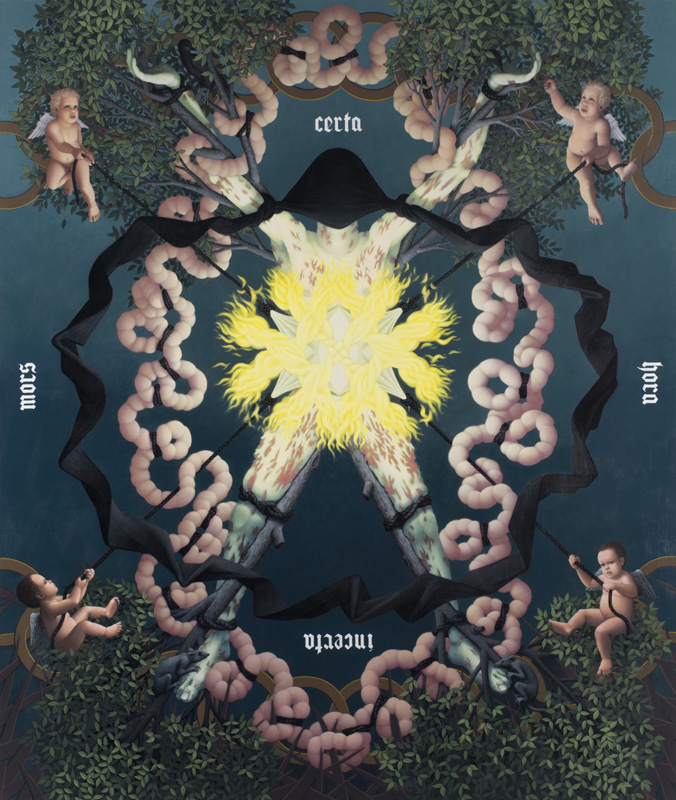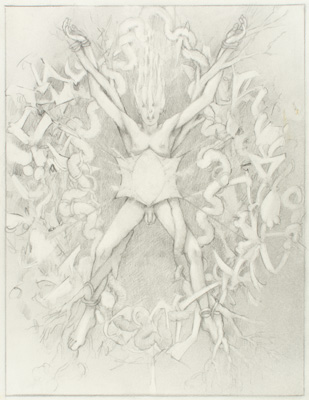
 |
| Mors Certa Hora Incerta 1995, acrylic on canvas 78 x 66 in. |
Mors Certa Hora Incerta |
The title, Mors Certa Hora Incerta, is a Latin phrase meaning - death is certain but the hour or time of death is uncertain. When I read it for the first time I was deeply moved by its elegant profundity, saying in just four words - we are all mortal and our moment-to-moment existence is uncertain. After a while I realized that it was also akin to my basic artistic focus on the idea of change and transformation. It was then that I decided to use the phrase, its meaning, and the words themselves, as the basis for this painting. In doing so it was my hope that the resulting work would be a comment on our shared human condition, and ultimately the shared condition of all living things. The symmetrical composition of Mors Certa Hora Incerta is dominated by a centrally located, solitary figure. His desiccated and wound covered body is in a spread eagle position with his arms and legs tied to tree branches. The branches extend out to the four corners of the canvas, which fill out into lush foliage that serve as a life-affirming counterpoint to the tortured figure. At the center of the painting his neatly eviscerated abdomen can be seen with its flayed ends tied and held open by black ropes pulled taut by four putti. Hovering above the open abdomen, and seemingly bursting from it, is a stylized knot of flames. The flames represent the figure's soul, the fire of life, and the purification of the spirit. The abdomen and the knot of flames are the painting's central focal point while also functioning as the singular light source of the piece. Another prominent element in Mors Certa Hora Incerta is the relationships between the knot of flames, the black cloth, and the stylized pink intestines. All three are ovals but are much different in color, tone, and texture. The oval shapes however are also similar in some ways thereby setting up interesting relationships. The black cloth forms a large horizontal oval that mimics the shape of the knot of flames while the large mandorla-shaped intestines are spatially positioned behind the black cloth oval, on an opposite vertical axis. The three ovals also relate directly with the figure. The knot of flames relates as I previous described. The black cloth shrouds the figure's head thereby hiding the identity of the figure, inferring the figure represents all of humanity. And the intestines organically wind around the figure, through the branches, and are tied and constricted periodically with black ropes. The black color of the ropes, like the black cloth, both symbolize death. |
 1995, acrylic on canvas 78 x 66 in. |
 1995, graphite on paper 10 1/2 x 8 1/8 in. (sheet: 12 1/8 x 9 in.) |
Another major element is the placement of forms at directional compass points. For example, the four words of the title, which are painted white to symbolize the purity of their meaning, are placed at the four cardinal directions – north, south, east and west. The four putti on the other hand are positioned at the four intercardinal directions – northwest, northeast, southwest, and southeast. And lastly, the hands and feet are positioned at four of the eight secondary intercardinal directions - north-northwest, north-northeast, south-southwest, and south-southeast. These directional elements all serve as starting points for the ropes, tree branches, and figure's arms and legs to lead the view's eye to the center of the painting. There are additional elements that contribute to Mors Certa Hora Incerta. The background is an empty spatial void that represents the nothingness of death. Its gradation of tone, light at the top to dark at the bottom, references a foreboding darkness below the canvas. Accentuating this violent, destructive presence are the abstract geometric forms that threateningly penetrate the bottom of the painting. The interlocking gold rings that arc in the background at the top and bottom provide another geometric form that contrasts with the organic elements. Lastly there are two crows and two rats that lurk in the foliage of the branches at the hands and feet of the figure. Their role in the picture is to function as another living creature whose mortality is linked to the life and death drama of the painting. - Brian Mains, June 2020 |